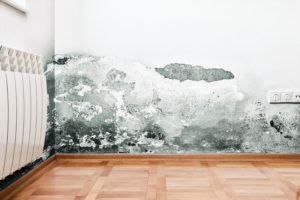 Although mold lives everywhere, extreme concentrations in your home can lead to unsightly stains, embarrassing odors, poor personal health, and even structural damage. One of the most dangerous scenarios is mold contamination within wall cavities. Since the mold is not immediately visible to the naked eye, it has time to spread across very large areas of the home, making future mold removal more challenging.
Although mold lives everywhere, extreme concentrations in your home can lead to unsightly stains, embarrassing odors, poor personal health, and even structural damage. One of the most dangerous scenarios is mold contamination within wall cavities. Since the mold is not immediately visible to the naked eye, it has time to spread across very large areas of the home, making future mold removal more challenging.
Mold in the wall cavity can sometimes occur due to water condensation when outdoor air comes in contact with the cavity side of the cooled interior surface, especially rooms decorated with impermeable wall coverings like vinyl wallpaper. These impervious wall coverings trap moisture between the finish and the gypsum board. The moisture from the outdoor air naturally passes through the exterior building envelope and may condense on the cool wallpaper adhesive. For this reason, vapor barriers should be on the warm side of a wall and should not trap moisture in the wall.
Sometimes the reason for mold in the wall cavity is a slow leak. Service leaks such as dripping pipes may not always become immediately obvious and are quite damaging over time. And those spores can be vigilant. Fungal spores are designed to withstand years, even decades, in stasis. Let Flood Restoration in Cincinnati investigate your situation and keep you safe with their mold removal services.
Professional Standards=Safe Work Sites
Indoor air quality professionals at Flood Restoration will evaluate the presence of mold in wall cavities by taking a sample of air from within the wall cavity. The samples can be either evaluated for the presence of fungal spores or for the presence of volatile chemicals produced by the molds. “Stroboscopic inspections” of wall cavities through a small hole might be performed.
Once the mold contamination of the wall cavity has been confirmed, several approaches might be used. The preferred option is always to remove the water damaged paneling, expose the mold, and thoroughly clean the wall cavity area under controlled airtight conditions with HEPA filtration. During mold removal operation, the mold is removed from the wall cavity which is then sterilized, mycotoxins are neutralized (specific chemicals are used for antitoxins neutralization) and the cavity is dried.
If the opening of the cavity is not practicable for whatever reason fumigation, gas ozone sterilization and sealing of mold can be used.
When Insulation Can Mean A Better Environment for Mold
Although wall insulation will help you stay comfortable in against the elements, commonly used thermal insulation products in wall cavities also influence interior wall surface temperatures. Water vapor condenses on the “backside” of sheetrock panels. As the insulation value is increased in the wall cavities, so does the potential for hidden condensation. Have Flood Restoration services evaluate the construction in areas of suspected mold.
Flood Restoration Services has the staff, expertise, and equipment to handle disasters of all sizes, from small floods to jobs as large as 1,000,000 square feet. We have experience working in all types of commercial environments, including manufacturing areas, warehouses, healthcare facilities, hotels, and office areas. Not only are we fully bonded and insured, but we are also approved by all major insurance providers to do quality mold removal.